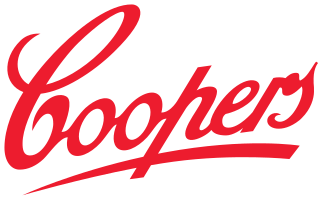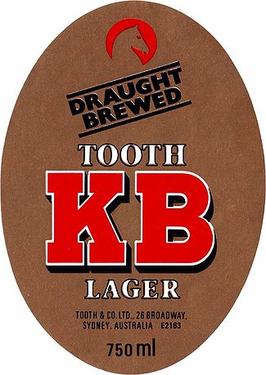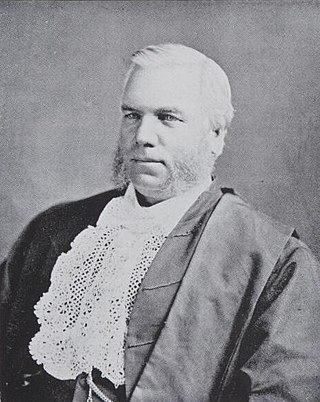Related Research Articles

Coopers Brewery Limited, the largest Australian-owned brewery, is based in the Adelaide suburb of Regency Park. Coopers is known for making a variety of beers, the most famous of which are its pale ale and sparkling ale. It is also the world's largest producer of homebrewing beer concentrate in cans. Cooper's also manufactures DIY kits, reusable plastic bottles, and boxed brew enhancers. Its shares are primarily owned by the extended Cooper family. The brewery has been headed by Tim Cooper as managing director since 1990, with Michael Shearer taking over the role from 1 March 2025. Melanie Cooper has been chair of the board since December 2023.

Tooth and Co was the major brewer of beer in New South Wales, Australia. The company owned a large brewery on Broadway in Sydney from 1835 to 1985, known as the Kent Brewery. It was historically one of Australia's oldest companies, having been established as a partnership in 1835. The brand was revived in 2015.
Melbourne Street is a street situated in the Adelaide suburb of North Adelaide, South Australia.

Woodside is a town in the Adelaide Hills region of South Australia. The town is between Balhannah and Lobethal, 37 kilometres (23 mi) from the state capital, Adelaide. Mount Barker is also nearby.

Oakbank is a town in the Adelaide Hills, east of Adelaide in South Australia. It is in the Adelaide Hills Council area. At the 2006 census, Oakbank had a population of 473.

The South Australian Brewing Company, Limited was a brewery located in Thebarton, an inner-west suburb of Adelaide, South Australia. It is a subsidiary of Lion, which in turn is owned by Kirin, a Japan-based beverage company. It manufactures West End Draught beer.

Sir William Milne was an Australian entrepreneur and politician, serving as the member for Onkaparinga in the South Australian House of Assembly from 1857 to 1868. He was elected to the South Australian Legislative Council in 1869, and was President of the South Australian Legislative Council from 25 July 1873 to 1881.

William Knox Simms was a brewer, businessman and politician in the early days of South Australia.
William Knapman was a hotel owner, brewer and businessman in the young colony of South Australia. He founded the hotel owning firm of Knapman and Son which survived past the mid-20th century. His descendants included four of South Australia's most famous sportsmen, a well-known pianist and numerous publicans.
William Henry Beaglehole was an early settler in the colony of South Australia, who became a businessman and served in public office.
Arthur Chapman was a businessman in Adelaide, South Australia, closely associated with the Theatre Royal, Adelaide.
Edgar Chapman was a brewer and businessman in Adelaide, South Australia, closely associated with the Theatre Royal.
The West End Brewery in Hindley Street, Adelaide, was a South Australian brewer of beer founded in the colony of South Australia in 1859 by a consortium of brewers. Its West End Ale was a popular brand and the enterprise was a successful one. The company merged with the Kent Town Brewery and Ben Rounsevell's wine and spirit business to create the South Australian Brewing, Malting, Wine and Spirit Company, in 1888, which continued to use the West End brand.
Oakbank Racing Club, formerly the Onkaparinga Racing Club, is a thoroughbred horse racing organization in South Australia. It is responsible for the Oakbank Racecourse and running the events of the Easter Racing Carnival on that course, culminating in the Great Eastern Steeplechase.
Charles Edward Mallen was a carpenter and brewer in the early days of the colony of South Australia.
Milne & Co. was a South Australian company of wine merchants, with premises on Grenfell Street, Adelaide, founded and for much of its history run by members of the Milne family.
The Pirie Street Brewery was a brewery situated on Pirie and Wyatt Streets, Adelaide, in the early days of the British colony of South Australia. It was succeeded on the same site after a few years by the Adelaide Brewery. Its original address was 50-62 Wyatt Street; today the buildings at 54–60 are heritage-listed in the South Australian Heritage Register, and there is a remaining building at 113 Pirie Street now occupied by the Hill Smith Gallery.
Walkerville Brewery was a brewer of beer in Adelaide, South Australia, originally founded in the 1840s. The company became a co-operative, and grew by admitting hotel owners as shareholders, and absorbed smaller breweries. After several amalgamations it moved its operations to Southwark and by 1920 it was South Australia's largest brewing company.
James Turnbull Thomson was a publican and brewer, recognised as the founder of Balhannah, South Australia.
Charles Williams was head brewer for several notable Australian companies.
References
- ↑ "Old Lion Hotel, Brewery And Former Malting House" (PDF).
The text in this Information Sheet was copied from the Heritage of the City ofAdelaide: An Illustrated Guide, (1996).
- ↑ Lion Brewery and Malting Company South Australian Register 14 April 1888 p.6 accessed 12 March 2011
- ↑ Cross Keys Hotel The Mail Saturday 14 June 1913 supplement p.3 accessed 12 March 2011
- ↑ Crosskeys subdivisional sale The Mail 28 September 1912 supplement p.1
- ↑ Hotels objected to The Advertiser 11 March 1914 p.5 accessed 12 March 2011
- ↑ "Brewing bid valued at $3.9m". The Canberra Times . National Library of Australia. 1 August 1973. p. 23. Retrieved 9 May 2015.
- 1 2 3 Sudden death of Mr. J. Johnston The Advertiser 14 April 1891 p.5 accessed 13 March 2011
- 1 2 Centenary of Oakbank The Advertiser 25 January 1940 p. 13 accessed 13 March 2011
- ↑ untitled article He died of throat cancer after three months' illness. South Australian Advertiser 23 December 1886 p. 6 accessed 13 March 2011
- ↑ Concerning People The Register 19 November 1901 p. 5 accessed 13 March 2011
- ↑ Death of Mr J. S. Johnston Barrier Miner (Broken Hill) 24 May 1892 p. 2 ac cessed 13 March 2011
- ↑ Sudden death of Mr F. A. Chapman The Advertiser 19 September 1925 p.17 accessed 12 March 2011